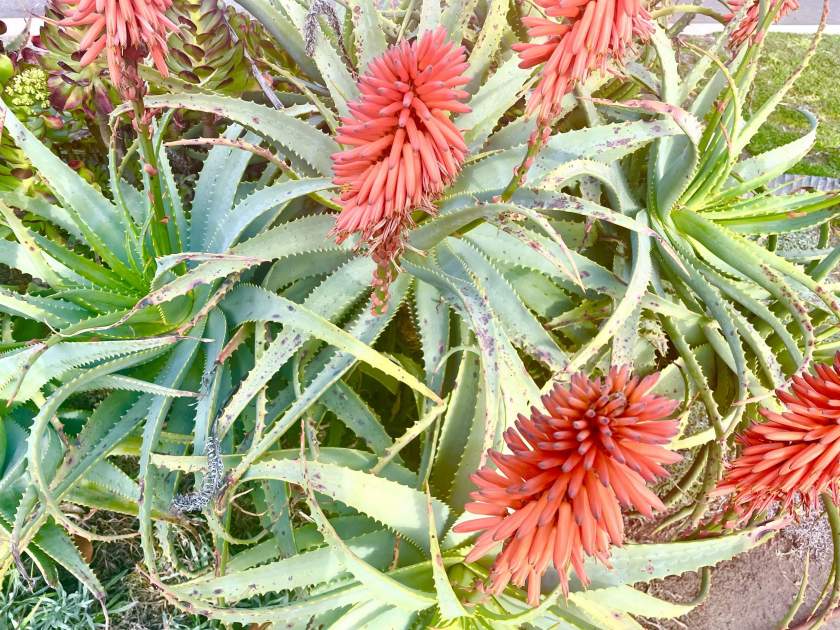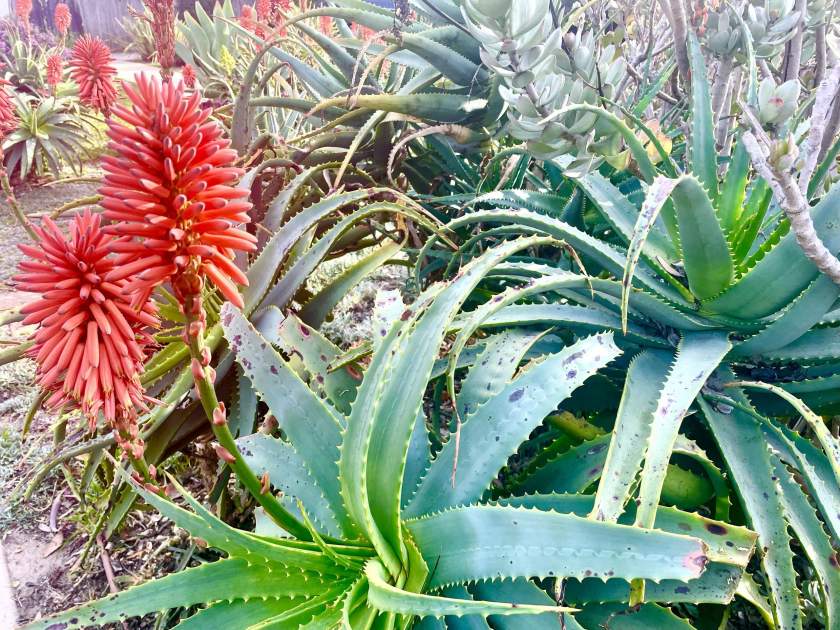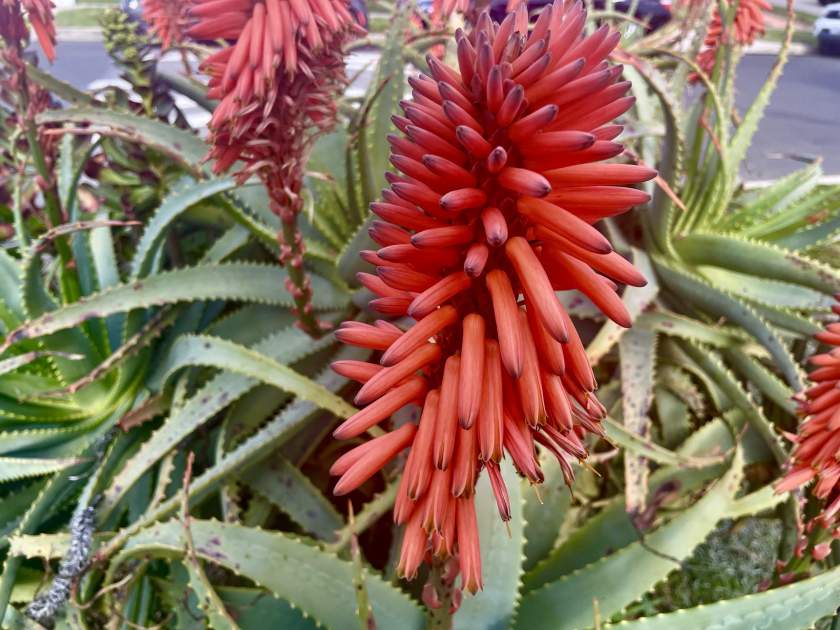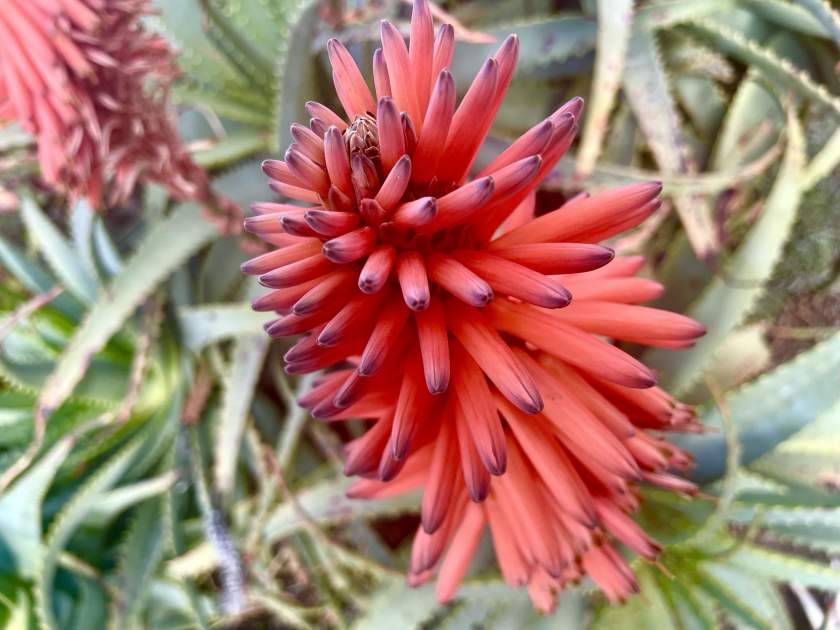Aloe arborescens, commonly known as Torch Aloe, Candelabra Aloe, or Krantz Aloe, is a succulent plant native to the southern regions of Africa. It belongs to the Aloe genus, which comprises numerous species known for their medicinal and ornamental qualities. This plant belongs to the Asphodelaceae family, a diverse group of plants known for their ornamental and medicinal qualities.
Aloe arborescens is a large, multi-stemmed shrub that can grow up to 10 feet (3 meters) tall. It features a rosette of thick, fleshy leaves that are gray-green in color and have a serrated margin. The leaves are arranged in a spiral pattern and can reach a length of about 2 feet (60 centimeters). Like other aloes, the leaves contain gel-filled tissue that stores water, enabling the plant to withstand periods of drought.

During the winter and spring months, Aloe arborescens produces impressive clusters of tubular, fiery red to orange flowers atop tall stalks, which attract pollinators such as bees and birds. The vibrant flowers create a striking contrast against the plant’s green foliage, making it a popular choice for garden landscapes.
Aloe arborescens is a resilient and adaptable plant that thrives in a variety of conditions. It prefers full sun exposure but can tolerate partial shade. When grown in the right conditions, it is relatively low-maintenance. It is drought-tolerant and requires well-draining soil to prevent root rot. In terms of temperature, it can withstand mild frosts but is best suited for warm climates. However, it can also be grown indoors as a potted plant.
To successfully grow and care for Aloe arborescens, consider the following:
Sunlight: Aloe arborescens thrives in full sun exposure, so it is best to place it in a location where it can receive at least 6 hours of direct sunlight per day. However, it can also tolerate partial shade, especially in hot climates, where it may benefit from some protection during the hottest part of the day.
Soil: Well-draining soil is crucial for Aloe arborescens to prevent root rot. Use a sandy or rocky soil mix specifically formulated for succulents and cacti. These types of soils allow excess water to drain quickly and help prevent waterlogged conditions.
Watering: Aloe arborescens is drought-tolerant and should be watered sparingly. Allow the soil to dry out completely between waterings. Overwatering can lead to root rot and other problems. During the growing season (spring and summer), water the plant thoroughly but infrequently. In winter, reduce watering even further, as the plant becomes somewhat dormant.
Temperature: Aloe arborescens can tolerate mild frosts and temperatures as low as 25°F (-4°C). However, it is best suited for warm climates with moderate temperatures. If you live in an area with colder winters, it is advisable to provide protection or bring the plant indoors during freezing conditions.
Fertilization: Aloe arborescens is not a heavy feeder, but it can benefit from occasional fertilization during the growing season. Use a balanced, water-soluble fertilizer specifically formulated for succulents and follow the instructions on the packaging. Apply the fertilizer sparingly to avoid overfeeding, which can lead to weak growth.
Propagation: Aloe arborescens can be propagated through offsets or stem cuttings. To propagate through offsets, wait until the offsets are well-developed and have a few roots of their own. Gently separate them from the parent plant and plant them in well-draining soil. For stem cuttings, allow the cut end to callous over for a few days before planting it in a suitable rooting medium.
Pests and Diseases: Aloe arborescens is generally resistant to pests and diseases. However, overwatering can lead to root rot or other fungal issues. It is important to ensure proper drainage and avoid excessive moisture around the roots. If you notice any signs of pests or diseases, such as mealybugs or rotting leaves, take appropriate measures to address the issue promptly.

Remember that Aloe arborescens is a slow-growing plant, and it may take several years to reach its full height and produce abundant blooms. With proper care, it will reward you with its stunning display of fiery flowers and its unique, architectural form. Enjoy its beauty and the potential medicinal benefits it offers as a cherished addition to your garden or indoor plant collection.
In addition to its ornamental value, Aloe arborescens has a long history of medicinal use. The gel extracted from its leaves is believed to possess various healing properties, including soothing sunburns, relieving skin irritations, and promoting wound healing. It has also been used in traditional medicine for its potential anti-inflammatory and immune-stimulating effects.
In summary, Aloe arborescens is an impressive succulent shrub native to southern Africa. With its tall stature, gray-green leaves, and stunning clusters of red to orange flowers, it adds a touch of beauty to any garden or landscape. Its ability to thrive in diverse conditions, combined with its low-maintenance nature, makes it an excellent choice for both experienced and novice gardeners. Whether grown outdoors in warm climates or cultivated as a potted plant indoors, Aloe arborescens offers not only aesthetic appeal but also potential medicinal benefits derived from its gel-filled leaves.





